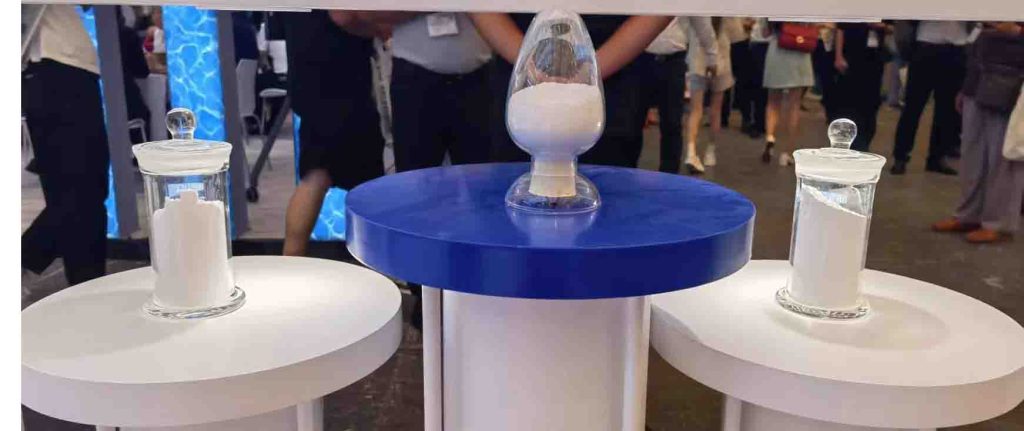Montmorillonite Powder
Introduction
A member of the smectite family of minerals, montmorillonite clay is distinguished by its peculiar structure, which consists of two layers of silica sheets sandwiching an aluminum sheet in the middle. To examine the particles, which are planar and have an average diameter of around one meter, one needs an electron microscope with a high enough magnification..
It’s a soft clay mineral that precipitates out of mineral-rich aqueous solutions as small crystals. The French village of Montmorillon is where the name originated. The mineral montmorillonite is often found in soil that has expanded. Montmorillonite is a kind of clay that can absorb varying amounts of water, greatly swelling the material when wet.
The process of crushing the clay into a fine consistency, resulting in a powder that may be used in a wide variety of settings. The positive properties of clay, namely its high cation exchange capacity and propensity to absorb water, are preserved in montmorillonite powder.
Surface and Interface Chemistry of Clay Minerals
Because of its unique chemical composition, bentonite montmorillonite clay belongs to a class of clay minerals like bentonite, than other types of clay. Montmorillonite clay layers that are built of silicon, the surface is made up of oxygen atoms. It can have aluminum or magnesium.
Bentonite
Bentonite clay vs montmorillonite clay are both types of clay and thickening agent. In the same way as bentonite clay falls within the smectite group of minerals, so does montmorillonite powder. Montmorillonite powder may be obtained from montmorillonite clay. It is mostly made up of mineral crystals that are either sodium or calcium montmorillonite. In short, bentonite is a naturally occurring mineral that is mined and processed by Zhejiang Camp-Shinning to produce montmorillonite clay and/or montmorillonite powder.
Montmorillonite Structure
Indeed, montmorillonite clay and montmorillonite powder possess incredible characteristics that makes it so important and helpful in a lot of industries. Here are some of its characteristics and properties.
Physical Properties
Montmorillonite typically has a density ranging from 2 to 3 grams per cubic centimeter when it is measured. Its crystal system is classified as monoclinic. This material is relatively soft, with a rating of only 1 to 2 on the Mohs scale, and is commonly discovered in a fine-grained form. Montmorillonite breaks in an irregular and uneven way, but it has a perfect cleavage.
The mineral doesn’t have a very bright shine and looks matte. It’s slightly transparent, allowing a small amount of light to pass through. Montmorillonite powders are available in various colors like white, buff, yellow, and green. The color of it may appear pale pink to red due to the presence of high-valence manganese. Montmorillonite’s physical properties play a crucial role in its identification and classification within the geological and material science domains.
Chemical Properties
It has a unique physical structure due to their layered sheets, which also define its chemical properties. It is made up of two types of structural sheets. It is tetrahedral sheet and the octahedral sheet. Tetrahedral sheet is made up of silicon-oxygen tetrahedra that are connected to each other.
When multiple tetrahedrons are placed together, they share three corners with each other. This creates a network that has a hexagonal shape. The fourth corner of every tetrahedron is linked to the adjacent octahedral sheet. The octahedral sheet consists of aluminum or magnesium atoms that are typically enclosed by six oxygen atoms from the tetrahedral sheet, as well as some hydroxyl groups.
It has a specific chemical formula of (Na,Ca)0.3(Al,Mg)2Si4O10(OH)2·nH2O. It has sodium, calcium, aluminum, magnesium, silicon, oxygen, and hydrogen. According to the International Mineralogical Association, the symbol for Montmorillonite is Mnt.
Typical Applications
Montmorillonite powder has many uses, but one of its most notable applications is in drilling fluids for oil exploration. This application benefits greatly from its unique properties, which make it highly effective. When you add Montmorillonite powder to drilling fluids, it can help you control the viscosity, improve lubrication, and enhance the overall fluid stability. When it absorbs water, it expands and creates a barrier that protects boreholes from collapsing. This barrier also helps in removing drilling cuttings.
Description
Zhejiang Camp-Shinning offers a high-quality montmorillonite powder, as well as bentonite clay. Our goal is to ensure that the organoclays made from montmorillonite meet the specific needs and requirements of our clients.
Packaging
At Zhejiang Camp-Shinning, we provide top-notch montmorillonite powder that can meet the varying requirements of businesses, whether big or small. To make sure that our product stays in good condition, we take special care when packaging the montmorillonite powder. We use kraft complex interiors with PE and offer 25kg bags or customized packaging options.
If you need to order a lot, we have two packaging options that might work for you: 800kg/pallet or 1MT/pallet. You can choose between wood pallets or plastic pallets depending on what you need. Zhejiang Camp-Shinning is committed to making sure their logistics are efficient by maximizing the amount of goods they can fit in their containers. They can fit up to 16 metric tons in a 20-foot container (20FCL) or 25 metric tons in a 40-foot container (40FCL) when using pallets. This helps their clients save money and ensures a smooth supply chain process. Only buy buy montmorillonite clay from Zhejiang Camp-Shinning.
Synonyms
In Spanish, it is referred to as arcilla montmorillonita, emphasizing its clay-like nature. In French, it is known as argile montmorillonite, highlighting its classification as a type of clay mineral.
Classification
As mentioned above, montmorillonite powder is classified as smectite clay mineral group together with bentonite, nontronite, saponite, hectorite and beidellite.
Functional Properties
Cation Exchange Property
If you break up montmorillonite clay into smaller particles, you’ll see that it has a bigger surface area in relation to its weight. When particles are made smaller to about 0.002-0.001 mm in diameter, their surface area increases significantly. The surface has the ability to attract and hold a larger amount of positively charged ions. The electrical conductivity of Montmorillonite clay is greatly affected by the cations that it absorbs. Modifying the ions in the sheet structure can bring about beneficial enhancements..
Electrical Conductivity
The particles of clay have pores. The flow of electricity through a pore is influenced by the fluid present inside it. Porous materials such as montmorillonite clay or powder have their electrical conductivity determined by both the electrical conductivity of the matrix material and the fluid present within the pores.
If there are a greater number of clay particles with a structure in a sample of montmorillonite, the overall electrical conductivity of non-saline soils will go up. The presence of exchangeable cations may be the cause. Additionally, it can cause the transfer of protons due to the dissociation of water content between layers. Montmorillonite clays exhibited the lowest electrical conductivity when there was a reduced amount of water present between their layers.
Heat Resistance
It has excellent insulating properties against heat. It is possible to increase the heat resistance of other materials by including it into their composition. Clay minerals, such as montmorillonite and bentonite, have been used by people for their thermal barrier qualities in a variety of applications that need heat resistance as well as flame retardancy. In order to make polymer composites more resistant to heat and fire, nanoclay is now seeing widespread use and research as a potential additive.
Water Sorption | Montmorillonite Powder
In response to changes in the relative humidity of their immediate surroundings, montmorillonite clay particles may either take in more water or give up some of the water that they already contain. When water is absorbed, it fills the spaces that are left behind between the layers of silicate that have been piled. Because of how it interacts with water, beneficial properties are brought into play as a consequence of this interaction. Because water molecules are present, it swells up as a consequence of their existence. This swelling is a result of the complex montmorillonite-water interactions that take place both between the particles and inside each particle itself. These interactions take occur both externally and internally.
In most circumstances, the transformation from montmorillonite into montmorillonite powder involves a process that involves increasing dehydration and a phase change. Developing into a clay that is more durable and long-lasting. The quantity of water that may be lost or acquired by various kinds of clay may cause the specific gravities of certain clays to change in an unpredictable manner. The large majority of the many kinds of clay that can be discovered are found in nature as mixes that contain many different kinds, such as carbonates, feldspars, micas, and quartz. This is true for the vast majority of the clay that can be found.


